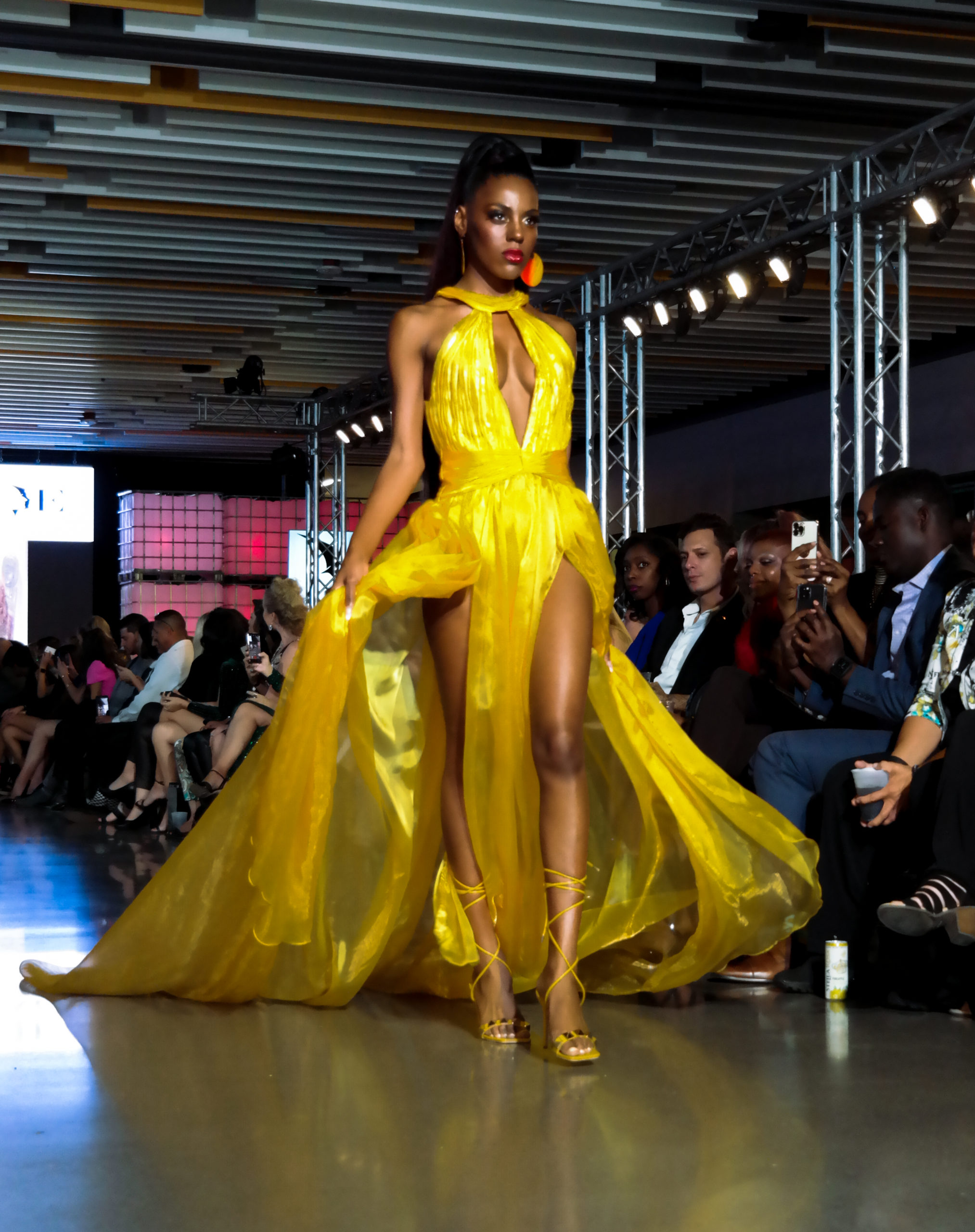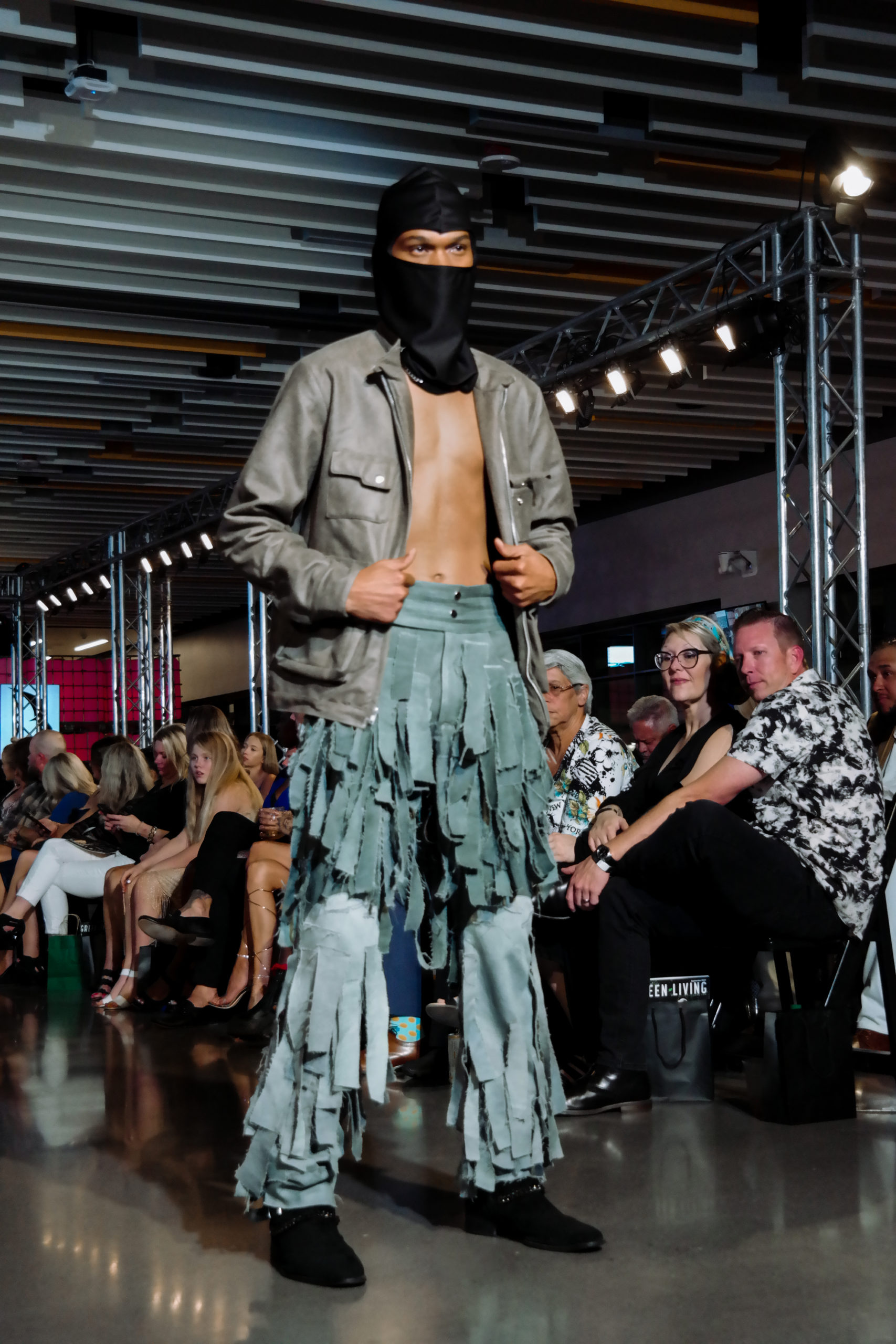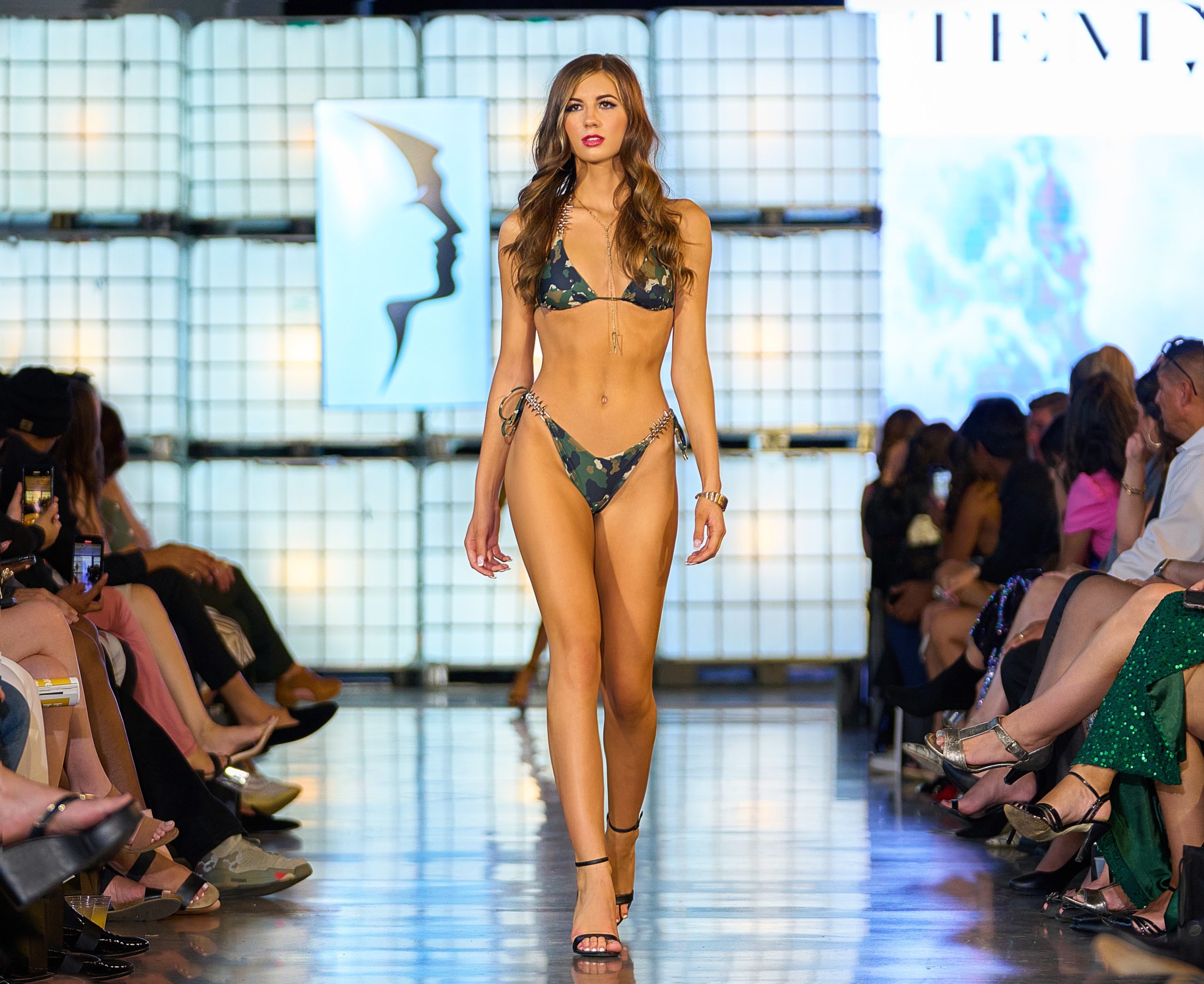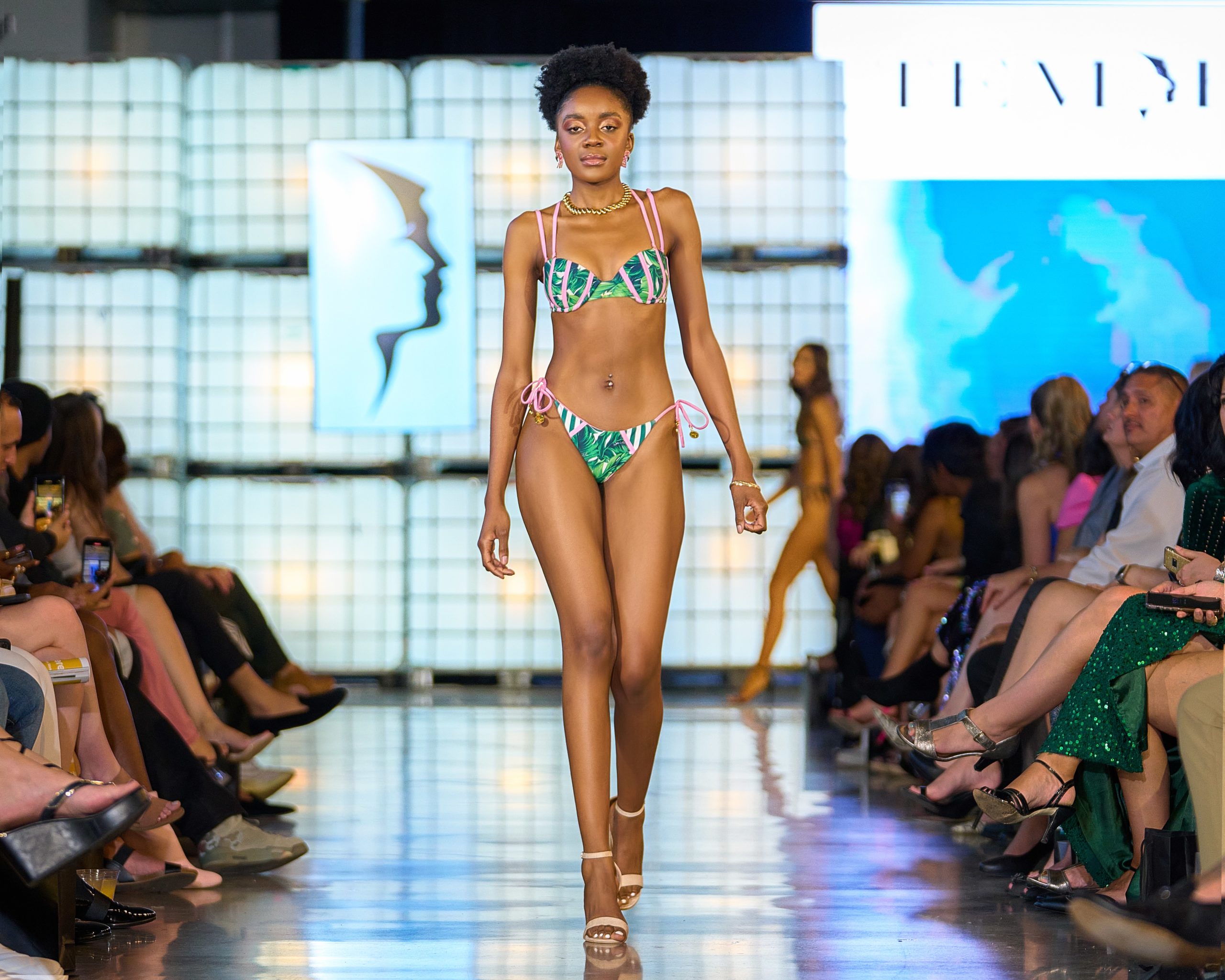After a long two years of attendees watching the annual festivities on a computer screen, a stylish full house eagerly awaited the much anticipated first launch of Tempe Fashion Week on Saturday, October 2.
I was intrigued when I heard the event would be held at Arizona State University’s Sun Devil stadium in Tempe. I imagined models striding down a runway held between the 50 and 100 yard lines. I pictured it going somewhat like the unusual baseball themed Boss x Russel’s showing in Milano this year in which they had models walking down JF Kennedy Stadium, a marching band, and a serving of peanuts provided to audience members. I was relieved to find out that the show had been elegantly assembled in the venue’s indoor event space just a short elevator ride away from the base of the stadium.
Inside, the sheltered outdoor hallway leading toward the bar and seating area was lined with vendors and a red carpet. Photographers, models and attendees lingered out there to mingle before the start of the show.
Designer Lauren-Bacall Snowden’s collection under her brand Sueño opened the show. The audience’s eyes widened as sheer pleats and poodle skirts tucked into metallic green flounced down the runway to a Tame Impala song.
When speaking to Snowden after the show, I learned of the value she places on functionality and comfort in her work. This stems from her upbringing in Seattle, where The North Face and Patagonia dominate every person’s closet to shield them from the wet conditions. After having served in the army for five years later in life, she was tickled at the idea of wearing something other than a uniform. “Now I want to wear the brightest yellow. I want to wear sequined everything and there is definitely a hat to wear with that,” exclaimed Snowden.
Despite wanting to wear the clothing of her choice, Snowden often felt frustrated shopping at retail stores due to changes in her body after she gave birth to two children. She began designing and upcycling her own clothing as a result. Now, you could never tell that one of her extravagant headpieces floating down the runway on Saturday had once been a microwave food cover from Goodwill.
Following Snowden and Sueño, Laboratory’s collection took us on a journey with asymmetrical abstract formal streetwear designed by Dontae Campbell. His use of unconventional textiles, medical attire and science-related-graphics emanated the elements of life that came along with COVID-19. Despite this, the collection spoke to the sense of hope and remembrance of those lost, with symbolic angel wings and jackets featuring embroidered hands folded in prayer.
The revealing work of Sheila Tucker’s first collection followed. Her models paraded boldly down the runway, dripping in emerald satin and shimmering evening blues with gold sprinkled throughout. Observers could clearly see the influence of Tucker’s Anishinaabe Ojibwe heritage from YellowQuill First Nation Reservation in Saskatchewan, Canada. In 2022, she will be a featured designer in Paris Fashion Week.
A bright yellow jumpsuit, sequined from head to toe and ending with fringed bell bottoms, caught my eye as Rachel Adam’s pageant dresses and jumpsuits flowed down the runway next. With all the colors of the rainbow, garnished with beautiful silk floral headscarves, her designs were dead set on having their wearer be the centerpiece of any room.
Pinstriped tunics and luxurious scarves within Senti’s designs were inspired by innovating West African attire for the modern man. Each look was refreshing and offered something unique, whether it was working capri pants into a masculine-office-chic or incorporating a leather jacket into culturally inspired business attire.
gave me a “cool girl” flair with transparent printed tops paired with sparkling pencil skirts and seafoam green lacy boot cut pants. Giant-jeweled cat eye glasses partnered with a psychedelic print dress lined with a serging of neon green, creating the telenovela femme fatale outfit of my dreams.
Christine Adar’s female warriors reigned over the catwalk, wearing hand-beaded and hand-painted ball gowns as they modeled her collection “Constantinople.” I am convinced that her knee-high boots in bright red, gold and cranberry snakeskin were what Nancy Sinatra was singing about in “These Boots Were Made For Walkin’.”



Adar’s collection was an ode to her grief after a tragic loss in her life and represented her own inner strength and connection with a higher being through it all. While a collection typically takes approximately 6 months to complete, “Constantinople” was created in a grand total of 6 weeks—an incredible feat for such immaculate designs.
Jennifer Lowe’s water vixens flaunted luxury swimwear from San Diego, California. Models sporting sexy bikinis and mono-kini’s pranced in stilettos to “Welcome to the Jungle” by Guns N’ Roses. The use of flags and camo in Lowe’s designs alluded to her patriotic upbringing. As a proud Arizonan, she finished with an Arizona flag bikini paired with suede boots and a matching fringed vest.
Lowe began designing luxury swimwear after her grueling weight loss journey. Standing in a dressing room, feeling fitter than the model in the poster she was staring at, she couldn’t figure out why no swimsuit flattered her. It dawned on Lowe that what she was looking at was fake—she realized it was false advertising used to market swimwear that was never made to fit a real woman’s body. From then on, she felt empowered to create swimwear that women could feel confident in and that would last through years of salt and chlorinated water use.



When J.C. Donaldson moved to Phoenix, he had no inclination toward fashion design, but he was infatuated with the city’s fashion scene. He developed a well-known blog titled “Being Dapper” that focused on financial legacy, etiquette, travel and fashion. Thankfully, with the encouragement from his family and friends at Phoenix Fashion Week, House of Donaldson was born. On Saturday, Donaldson’s muted shades of dapper tailored suits combining floral and plaid prints made their appearance on the runway. The goal of his designs is to keep the polite, well-mannered and crisp Southern gentleman alive, as he hopes to inspire the typically casual Arizona market into more debonair attire.
“The art of being a gentleman is being chopped away every year because it’s not being passed down to the next generations. With divorce rates skyrocketing, fathers are not in homes. I call it ‘lost-man syndrome.’ Being dapper was a basic way of keeping an old thing new, and I still kind of try to do it with the brand,” said Donaldson.
The House of Donaldson showing ended in an explosion of color from their rainbow asymmetrical pleated tulle dress, demonstrating both the technical and artistic range of Donaldson and his team.
Snowden’s sustainable and upcycled nature arrived again with Amanda Jacobs’ collection for Classic Reclaim, whose vintage gold lace and lady gloves cohabitated with streetwear. Her one-of-a-kind versatile pieces are fit to be in everyone’s capsule wardrobe.
Hairstylists and makeup artists rushed around us as I interviewed Jacobs backstage prior to the show. She answered my questions eloquently, despite being in the midst of getting her eyelashes glued down. We started discussing how custom pieces have more meaning to the customer and are handled with more care. Fast fashion from stores and online shops like Forever 21, H&M and Shein typically get thrown out or donated by their consumers. This is usually done less than a year after purchasing in exchange for new trends.
“They do not create a space in your heart,” Jacobs said regarding fast fashion items. “Putting meaning [into] clothing is what makes something special. If you think of your favorite things in your closet, they are probably connected to a memory. I try to really hone in on that by allowing people to create their own memories and letting the garments create new memories. Just because they had a past life does not mean they can not have a future life.”
The Sacred Hearts Co. collection neared the end of the show and featured handmade vintage jewelry, leather, fleece, and denim pieces. An iridescent jacket floated by, appearing green at some angles and a warm auburn at others. A pair of eye-catching denim fringed pants walked past. A jacket composed of unique textiles such as shaggy fur, orange leather, and ivory suede, was partnered with brown leather pants. Most of the looks in the collection were paired with ski masks in various patterns and colors, perhaps a homage to recent COVID ridden years.
I thought Camille Nicole’s designs teaming with a dreamy amount of tulle, dramatic sleeves on transparent dresses, and petticoats adorned with silk flowers was an extravagant ending to the show, but it paled in comparison to what Nicole herself wore. She came waltzing down the runway in large bedazzled fairy wings spanning about five feet wide, with an emerald catsuit of mesh placed between shattered bits of green mirror. Despite appearing last in the show, her designs were certainly not the least.
At the end of the show, the founder of Tempe Fashion Week, Sebastien Verstraet, spoke about the platform that his organization stands on, which highlights sustainability, diversity, equity and inclusion.
“It’s more than a fashion show to me. It’s about bringing people together under a common interest and to make it a great experience for everyone. My goal and vision for Tempe Fashion Week was always to be diverse, inclusive and sustainable,” said Verstraet.
This is an exciting premise since lots of fashion brands tend to use diversity and inclusion as a performative gesture and trend. I’m hopeful that this will not be the case with Tempe Fashion Week and that they continue to ask the question: how can a platform this large ensure that our diversity efforts are genuine and increasingly more inclusive each season? Knowing this will help establish these as a foundation to build upon.
Ableism, ageism and sizeism run rampant in the fashion industry, alongside other methods of discrimination. Not to mention the gatekeeping of the fashion world in regards to race. White fashion designers still dominate the industry at a whopping 59.6%, while Black designers sit at 6.3%, Asian designers at 13.2%, and Hispanic/Latino designers at 15.2%.
It can be baffling to learn that the industry is missing the mark when statistics suggest otherwise. The extended-size market for women in the U.S. will grow to $32.3 billion this year; the global adaptive clothing market was valued at $250.1 million in 2019; and the modest fashion industry is valued at $277 billion. Gender-neutral clothing is becoming more popular every day, with newer generations being more open to the idea of gender existing on a spectrum. I can’t wait to see Tempe Fashion Week grow and evolve, including silver-haired, differently-abled, transgender, nonbinary, and plus-sized individuals in years to come.
Designers such as Kim Warmack, a wheelchair user who designed her own bright red patterned dress with puffy sleeves, would be a great addition. She is a local designer who founded Adaptability, an adaptable clothing brand for differently-abled customers. She has held back on showcasing her designs due to the time she spends helping other designers and teaching at local elementary schools. However, this year, she is looking to showcase her designs in the spring at Phoenix Fashion Week 2022.
I look forward to the inclusivity and sustainability that Tempe Fashion Week will nurture in the Phoenix fashion scene and hope it will inspire more people within the fashion industry to call Arizona their home. To stay up to date on their spring show, you can follow them on Instagram at @tempefashionweek or check out their website.
Keep up with all of Green Living’s original content online and on social media.





